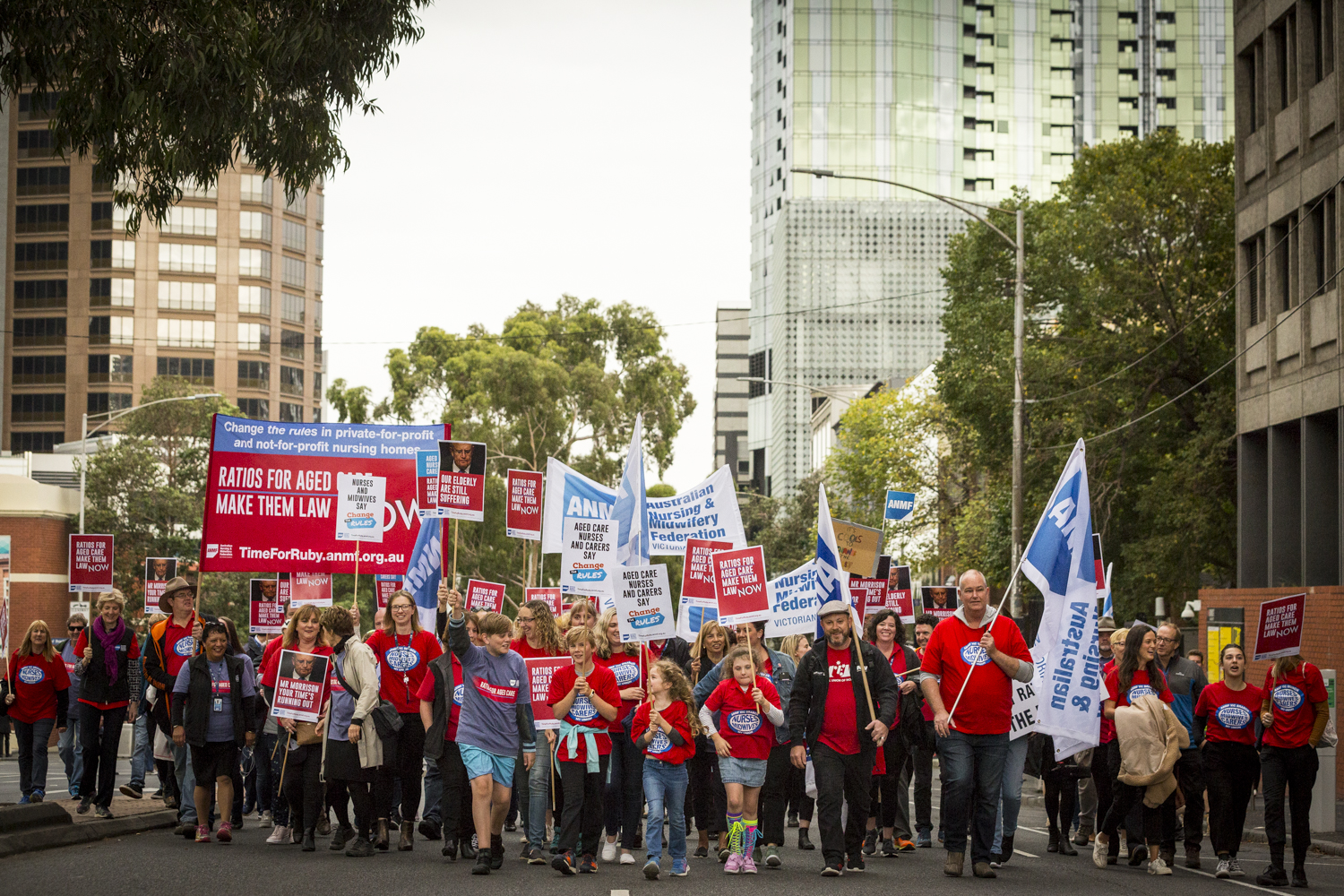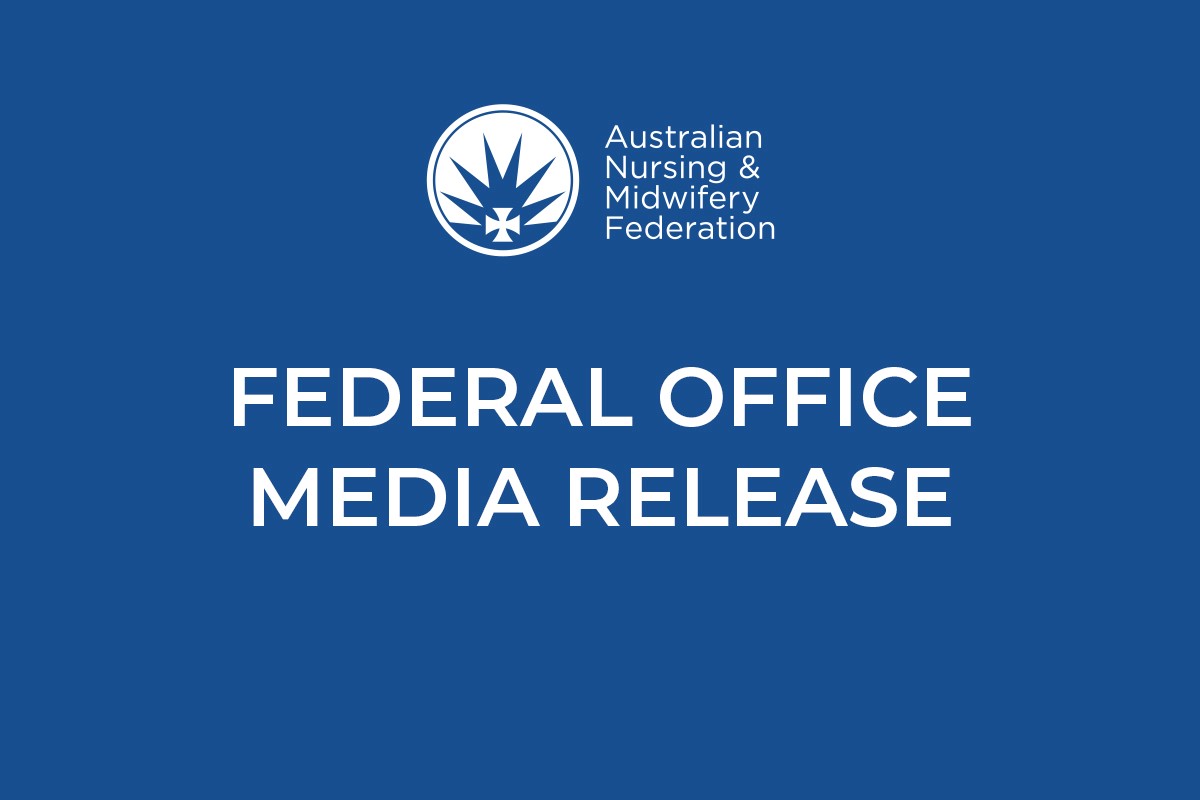
ANMF members rally in 2019 to change the rules to quarantine funding for private aged care nurses and carers and their wages.
If you consider the level of Victoria’s private* residential aged care wages and staffing it would be a reasonable assumption that providers need more funding.
The Federal Government provided the aged care sector – including home care – with $19.9 billion in 2018-19 subsidising services for about 1.3 million people.
The largest funding chunk, $13 billion, went to residential aged care providers to care for 242,612 people for 12 months. Those residents also paid the providers another $3.4 billion.
So, $16.4 billion sounds like a lot of money to provide nursing home services. If they need more money to improve the number of nurses on each shift and improve wages, how much more do they need?
We don’t know.
To be able to argue that the private residential aged care sector needs more funding we need to know how the billions are currently spent. And we don’t.
To campaign for more funding, we need to be confident the extra dollars will be spent on the intended purpose.
And we are not.
The billion-dollar figures forked out by taxpayers can be found in the Federal Government Aged Care Financing Authority’s reports on the funding and financing of the ‘aged care industry’. They are comprehensive big-picture reports, but do not reveal anything about the percentage of funding spent on clinical or personal care, food, medications, rehabilitation or palliative care services.
How can we spend billions on nursing homes and still not have enough nurses? It’s a question we asked in the ANMF (Vic Branch) television campaign One day it will be all of us launched in late 2020.

An image from the ANMF (Vic Branch) One day it will be all of us television and social media campaign questioning how we can spend billions on private nursing homes and still not have enough nurses.
Not so ancient history – the consequences of no strings
Before enterprise bargaining was introduced in the 1990s, hospital and nursing home nurses took home the same pay.
With each new public sector enterprise agreement, the pay gap widened between the two sectors.
Successive federal governments have earmarked more than $2 billion for aged care nurses’ and carers’ wages since 1996 – starting with the Labor Keating government allocating $50 million for a pay rise.
Only once has ‘wages funding’ been quarantined, and as it turns out that was only temporary.
In 2002, heeding the intergenerational report’s looming ageing population warnings, the then treasurer Peter Costello told Australians in his budget speech the Coalition Howard government would invest in nurses’ wages and the workforce.
‘Subsidies for residential aged care will be increased to allow better pay rates to be offered to aged care nurses so providers can attract and retain more aged care nurses,’ Mr Costello said.
So, what happened to the $195.8 billion over four years for increased subsidies and $26.3 million over four years for more aged care nurses? No strings attached, no accountability. Minimal wage increase.
Three years later Julie Bishop, then minister for ageing in the Coalition Howard government, gave aged care providers an extra $877.8 million specifically to, you guessed it — improve wages.
Her 2005 media release states aged care providers would be able ‘to offer more competitive wages to nurses and other staff, thereby enhancing further their ability to provide high quality care and support.’
‘The new payment will allow providers to increase wages in line with demand in order to attract and retain quality staff,’ Ms Bishop said.
In the months afterwards, ANMF began aged care negotiations for wages and conditions. Aged care employers continued to tell ANMF they could not afford improved wage increase percentages.
2013 was the last time a federal government talked about better aged care pay. The Labor Gillard government allocated $1.2 billion to increase the wages of those who worked in nursing homes. Strings were attached. This time the funding was tied to wage outcomes in enterprise agreements.
Months later the Coalition Abbott government was elected after promising the additional funding reserved for wages would instead go into the aged care providers’ general funding pool.
The point here is not to rake over ancient aged care history – although it was a hard-fought national ANMF campaign that secured that wage funding and it was only seven years ago.
The point is that the funding was not quarantined or tracked. Each time ANMF started bargaining after a cash injection, private aged care providers said they could not afford wage increase percentages to decrease the wages gap.
When employers agreed to modest increases, care hours were reduced.
What can be done about it?
At the time of print, Federal Parliament was debating independent Senator Stirling Griff’s Financial Transparency Bill.
If passed the aged care legislation would be amended to require residential aged care providers to disclose their income, costs of food and medication, staff and training, accommodation, administration and monies paid to parent bodies in ‘annual financial transparency reports’.
The Morrison Government does not support the Bill, arguing it is a piecemeal approach to aged care reform that pre-empts the royal commission’s recommendations.
‘The usefulness of the proposed public information is not clear, because it has the potential to be misleading to consumers,’ Liberal Senator Sarah Henderson argued in the debate of the Bill’s second reading.
Labor Senator Kristina Keneally told Parliament the Federal Opposition supported greater financial transparency of how providers spent the aged care billions.
‘We don’t know how much aged care providers spend on food. We don’t know how much they spend on medication. We don’t know how much they spend on staff wages or how much they spend on staff training. And how much do they pocket as profit?’ Senator Kenneally said.
The Greens also support more stringent public reporting requirements.
‘We know we need a better understanding of how money is spent. We need to be paying the staff in aged care better, and we’ve known that for a very, very long time,’ Greens Senator Rachel Siewert said.
All eyes on the royal commission
Next month, the Royal Commission into Aged Care Quality and Safety will hand down its final report and recommendations.
ANMF has argued in its evidence before the royal commission it must recommend measures requiring providers to account for how they spend taxpayer funding.
Regardless, when the recommendations are handed down, we will hear loud calls from the private aged care sector for more money.
To avoid history repeating, there must be strings attached. We must have funding accountability and transparency.
* Private aged care refers to private and not-forprofit.
Aged care snapshot
Federal funding for residential aged care
| 2018-19 | |
| Total aged care funding | $19.9 billion |
| residential aged care funding | $13 billion |
| residential aged care profit | $264 million |
* Data from the Federal Government’s Eighth Aged Care Financing Authority’s Funding and Financing of the Aged Care Sector Report.
People
| 2018-19 | |
| Number of people living in residential aged care each year |
242,612 |
* Eighth Funding and Financing of the Aged Care Sector report.
Workforce between 2012 and 2016
| Percentage of the workforce | |
| Registered nurses | decreased from 21% to 14.6 % |
| Enrolled nurses | decreased from 13.1% to 10.2% |
| Personal care workers | increased from 58.5% to 70.3% |
* National Institute of Labour Studies’ National Aged Care Workforce Census and Survey 2016
Beds and facilities
| Aged care beds | |
| In Australia | 213,397 |
| In Victoria | 56,744 |
| Public aged care beds | 5609 |
| Private and not-for-profit beds | 51,135 |
| Aged care facilities in Victoria | |
| Public aged care facilities | 156 |
| Private aged care facilities | 328 |
| Not-for-profit aged care facilities | 284 |
*Data from Australian Institute of Health and Welfare GEN aged care and www.2.health.vic.gov.au – public sector residential aged care services.




